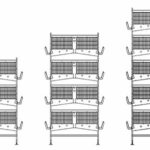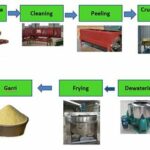Following the high demand for poultry products this season, Afrimash has seen the need to bring resources to farmers. This is to help them maximize production for the season while stocking for the new year.
Here is the highlight of the November edition of our monthly webinar with our facilitator Mr Oladayo Ogundiran.
A graduate of the Federal University of Agriculture Abeokuta with a degree in Animal science [Bachelor of Agriculture], Mr Oladayo’s work experience includes the following positions:
- Production assistant at Grandparents stock farm, Obasanjo farm at Lanlate.
- Farm manager at Bitmas integrated dairy farm, Zaria
- Technical sales and brand manager, Dalom farms subsidiary of worldwide Dalom.
- Director of business development and quality requirements at Grinphield farms and agribusiness.
A senior colleague in the industry about 7years ago once said that egg production is already oversaturated and there is enough vacuum for the meat(broiler) production in Nigeria
– Mr Oladayo Ogundiran
Obviously, this is the position we find ourselves since the closure of the border – no turkey, chicken, and fish might be coming in. This is an opportunity for many farmers, although there are many threats if one is not equipped with the right information and adequate knowledge.
The first step is sourcing your day-old chicks from the right hatchery. There is an increasing demand for day-old chicks by poultry farmers and this creates a loophole for unwarranted practices within the hatchery business. So, one needs to be very careful when sourcing day-old chicks.
The pen is prepared before the arrival of chicks which is known as LITTER MANAGEMENT.
Floor and Litter Management.
The farmer needs to have a clean environment before chicks arrival. If you have a new pen, you need to put new litters in the form of wood shaving (not sawdust). If you have an existing house, remove all litters, wash with detergents and bleach. Make sure every corner is well-washed. After placing the litter, spray with insecticide (DD force or sniper) and disinfectants. Lysol is preferable.

Equipment sanitation
Wash your chick drinker and tray thoroughly, possibly with detergents and disinfectants if you have used them previously. Subsequently, use ordinary water to wash. If you use detergents, it may not be properly rinsed and may affect the quality of drugs and vaccines.
Temperature management during brooding
This is very important. You need to take total charge of the internal temperature of the pen. Enclose the pen with tarpaulins or transparent nylon. It creates a warm, comfortable environment. The transparent nylon will also help to light up the pen during day time. There are standard temperature requirements, but most importantly, you need to constantly check the temperature at the roof and at the level of the birds. If the roof temperature is more than the level of the birds, you need to bring up the curtain to avoid heat stress which will not make the chicks to eat.
The farmer also needs to preheat the room to a required temperature at the level of the birds. It is possible you heat the room and you are sweating and when you bend down at the level of the birds, it is very cold.
Please take note: you can heat with gas brooders or charcoal or kerosene stove. When using charcoal or kerosene be careful of smoke.
There are different types of houses for rearing poultry birds and this is explained below
There is the closed system – this is used by big industrial chicken farms and it is fully automated in terms of temperature control, humidity control and so on. Feeding and drinking system is fully automated too. You have one person taking care of about 50,000 birds. It is a very good system but more expensive.
We also have the open house system and it is what the facilitator concentrated on. You need to regulate temperature and so on with charcoal, and feeding is manual, etc.
Broiler unlike pullet, do not need so much heat. Depending on the weather condition, the supply of heat to the broiler house should be a maximum of 3 days. They also need a bit of chilly weather to help increase food consumption.
Lighting
For the first 3 weeks, they need an average of 23 hours of light. It helps to feed, drink and also run around and generate metabolic energy. 1 or 2 hours is alright for sleep. The farmer can supply light through the night with solar lamps if there is no electricity on the farm as this helps to save cost. The transparent curtains will help in lightening during the day time
Feed and Feeding

A good and palatable feed is the key. When buying your feed or producing one, check your raw materials for anti-nutritional factors. Most importantly, check for moulds. If the feed is caking or too dusty, don’t buy. Check the expiry date as well. The poultry farmer needs to be critical when buying feed.
Mr. Oladayo advised most farmers to try to use a pre-starter diet for the first week as he does. Broilers should be ready for slaughter in 5-6weeks with an average weight of 1.8 kg. The feed conversion ratio of most broiler is 1:2 – that is, to get 1 kg of broiler live weight, the farmer needs 2kg of feeds based on prevailing factors.
Give the birds feeds in bits – possibly every hour and here are some reasons why:
- It will help stimulate the appetite of the chicks.
- It will help you have interaction with the chicks.
- It helps to do a cleanup of their feed so there is nothing the rodents can feed on
Drugs and Vaccines
When the birds arrive, you can place papers on the floor. It helps them not to eat litters. You can also broadcast the feed on the paper to help them feed as close as possible.
Speak to a vet in your area to cross-check your vaccination schedule, because it varies from location to location depending on the prevailing disease outbreaks. For example, in some areas, farmers give Lasota every 3- 4 weeks. Confirm what works in your farm location.
Please check the vaccine expiry date before use, also confirm the cold chain. Always take a vaccine carrier along to buy vaccines. It is not advisable to put your vaccine in the freezer.
Use of feed grade anticoccidial is very important if you are milling your poultry feed yourself. Also, ensure adequate ventilation and be sure to always breathe fresh air in the pen. Try as much as possible to avoid wet floor in your broiler pen. If the pen is wet, it will be difficult to treat coccidiosis, which is a major broiler problem.
You can buy solar lamps to help with lighting to supply a minimum of 23 hours light in the pen. The more the birds have access to light, the more they eat and gain weight.
Questions:
Question: Thank you so much sir. My question is – what will happen if the vaccine is stored in the freezer?
Response: You don’t freeze vaccines because there is a particular temperature they live with. Most vaccines are countered if it goes beyond the temperature recommended by the manufacturer – the vaccines that are to protect can become harmful.
Question: Does too much exposure to light not affect their health?
Response: There is no harmful effect of too much light on birds, they only do not get sleep and you don’t need them to sleep.
Question: Kindly throw more explanation on the heat for broiler. Does it mean 3 days heating is enough?
Response: Now heating may be more than 3 days depending on the weather condition or you may not need any external source of heat depending on the weather condition. But most important is the fact that broilers need a more chilled environment because of fat build-up and metabolic energy needed.
Question: Hello I’m Araba Ganiyat. Well done, sir.
What can be done to female broilers cause they don’t seem to eat like the males?
Response: Female broilers also grow big. Please always check the weight. Sometimes you could have a chicken that looks dwarf but could weigh more than the tall ones.
Question: Good day. My name is Najeem Ibrahim. My question is, how can we get the day-old chicks?
Response: Check afrimash.com
Question: How feasible is organic broiler farming in large quantities?
Response: With adequate biosecurity. Just mill your feed yourself.
Question: Indeed very interesting. 23hours of light to make them eat. Hence more food more production cost. Will this not affect profit?
Response: If you check your feed conversion. It adds no additional cost
Question: Thank you sir, can you list 3 best hatcheries to get DOC?
Response: Check afrimash.com
Question: Thanks Dr. What is the major difference between kuroilers and broilers? Which is the best for profit-making?
Response: Kuroiler and broiler are not the same. Broiler has more meat over a short period and is tender. It largely depends on your market
Question: Please can you give the ratio of the diet needed by day-old chicks if we want to mill it ourselves?
Response: There is an eBook on the ration of different types, you can buy one on Afrimash.com
Question: If they eat round the clock, how do they convert the feed they have eaten. I think the rest is necessary for them to convert the food to something good.
Response: Just like a human, it is not when u are sleeping that food is being converted. To say the fact when you eat late and sleep you tend to have indigestion because your system is not very active while you sleep. Same is for birds
If you missed this training, don’t forget to subscribe here for an update on our next training.















5 thoughts on “Broiler Production: Best Poultry Farm Management Practices”
How can we avoid water on the floor in a polutry pen.
Hello Raji,
Thank you for reaching out to us
As regards your inquiry, for grown birds in cages, water on the floor is easy to avoid by using a drinking system,
But for birds raised on the floor, water on the floor can be reduced by;
1. Remove litter caking as soon as the house is empty
2. Keep the house warm
3. Keep fans running
4. Eliminate house leaks
5. Run the fans when pre-heating
6. Adjust and clean the drinker system
7. Use circulation fans throughout the flock
8. Check relative humidity
9. Take advantage of the day/night difference
10. Be bold with timer settings so as to keep up with removing the wet litters
We have all you need to manage your poultry farm at discounted rates in our cradle to table category, Click here to view
Best Regards
Well and clear explanation, I’m Abdussamad Sani Hamisu from Kano State, mine is to know what the required temperature for brooding broiler chicks in Kano State?
Hello Abdussamad,
Thank you for reaching out to us

As regards your enquiry on brooding broiler chicks, I have attached a file below which contains the recommended temperature for brooding chicks:
Don’t forget to place an order for the poultry equipment needed to brood your chicks by clicking on the product of your choice below:
– Electric Brooder
– Gas Brooder with Infrared Functions
– Quality Brooder Guard for Chicks
– Infrared Heating/Brooding Lamp
You can reach out to us via:
Call: (+234) 809 409 1115
WhatsApp: (234) 808 280 8271
Email: info@afrimash.com
Thank you for choosing Afrimash
VERY NICE LESSON WILL KEEP IN PRACTICE